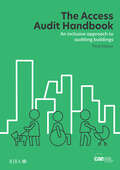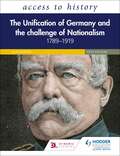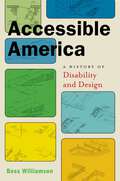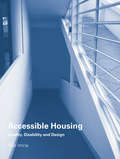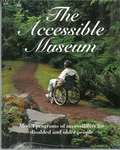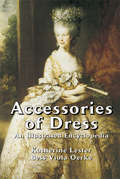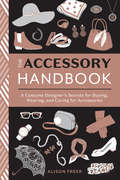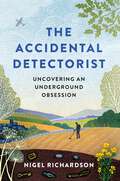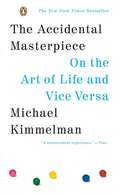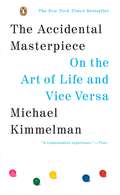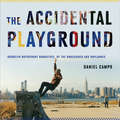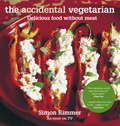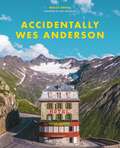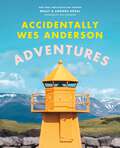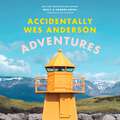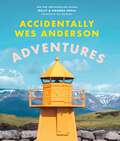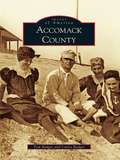- Table View
- List View
Access and Widening Participation in Arts Higher Education: Practice and Research (The Arts in Higher Education)
by Samantha BroadheadThis volume brings together a range of practitioners, managers, and researchers who work within the field of arts higher education to reflect on strategies to increase access and widening participation (WP). The issues presented in this book are situated within a wider global context where countries are seeking greater harmonisation of higher education as students and workers become more mobile, crossing international borders. The chapter authors address various issues within higher education institutions from a WP context, including areas such as creative writing, music, art and design. In exploring these issues the editor and her chapter authors seek to answer how those teaching in arts higher education can promote the value and quality of their work while ensuring fair access and wide participation for all.
The Access Audit Handbook: An inclusive approach to auditing buildings
by (CAE) Centre for Accessible EnvironmentsOur buildings and environments should be inclusive to all, but how can we assess this? The Access Audit Handbook is an indispensable tool for auditing the accessibility of buildings and services. This book offers straightforward advice about undertaking access audits and explains how they make buildings, environments and services more inclusive. Following the audit, the book explains how each of the various report formats works best to communicate recommendations in the content of current legislation, funding requirements and best practice in building management. Well established as the best resource for conducting access audits, the third edition of The Access Audit Handbook is fully up to date with the latest legal and technical standards as well as developments in equipment and building maintenance. Featuring advice on: Commissioning an access audit Audit methodology Making recommendations Report writing The practical guidance is supported by case studies, worked examples and checklists.
Access for Disabled People to Arts Premises: The Journey Sequence
by Geoffrey Lord C Wycliffe NobleIllustrating actual building design solutions that have been created to improve accessibility for disabled patrons and performers, the 'Journey Sequence' outlines the best examples of design innovation produced in response to new and upcoming legislation.A knowledge of how to design for the disabled can be crucial in winning contracts and having designs accepted. This book shows how the practical implications have already been successfully approached.Covering the whole sequence from parking, to entry, and including details of facilities for the visually and hearing impaired users, advice is given on the methods designers should use in assessing the requirements of disabled people. This is not a publication giving theoretical prescription but rather an illustrated record of achievements in buildings of all sizes where proper access to the disabled has been created. It includes 14 case studies and examples that illustrate the diverse ways that accessibility has been incorporated into arts buildings throughout the UK. This includes Cinemas, Theatres, Concert Halls, Opera Houses, Museums and Libraries. The author team highlights specific design details that are particularly unique, to stimulate the reader and show that creating better accessibility for the disabled both demands and creates innovative design.
Access to History: The Unification of Germany and the Challenge of Nationalism 1789–1919, Fifth Edition
by Vivienne SandersExam board: Pearson Edexcel; OCRLevel: AS/A-levelSubject: HistoryFirst teaching: September 2015First exams: Summer 2016 (AS); Summer 2017 (A-level)Put your trust in the textbook series that has given thousands of A-level History students deeper knowledge and better grades for over 30 years.Updated to meet the demands of today's A-level specifications, this new generation of Access to History titles includes accurate exam guidance based on examiners' reports, free online activity worksheets and contextual information that underpins students' understanding of the period.- Develop strong historical knowledge: In-depth analysis of each topic is both authoritative and accessible- Build historical skills and understanding: Downloadable activity worksheets can be used independently by students or edited by teachers for classwork and homework- Learn, remember and connect important events and people: An introduction to the period, summary diagrams, timelines and links to additional online resources support lessons, revision and coursework- Achieve exam success: Practical advice matched to the requirements of your A-level specification incorporates the lessons learnt from previous exams- Engage with sources, interpretations and the latest historical research: Students will evaluate a rich collection of visual and written materials, plus key debates that examine the views of different historians
Access to History: The Unification of Germany and the Challenge of Nationalism 1789–1919, Fifth Edition
by Vivienne SandersExam board: Pearson Edexcel; OCRLevel: AS/A-levelSubject: HistoryFirst teaching: September 2015First exams: Summer 2016 (AS); Summer 2017 (A-level)Put your trust in the textbook series that has given thousands of A-level History students deeper knowledge and better grades for over 30 years.Updated to meet the demands of today's A-level specifications, this new generation of Access to History titles includes accurate exam guidance based on examiners' reports, free online activity worksheets and contextual information that underpins students' understanding of the period.- Develop strong historical knowledge: In-depth analysis of each topic is both authoritative and accessible- Build historical skills and understanding: Downloadable activity worksheets can be used independently by students or edited by teachers for classwork and homework- Learn, remember and connect important events and people: An introduction to the period, summary diagrams, timelines and links to additional online resources support lessons, revision and coursework- Achieve exam success: Practical advice matched to the requirements of your A-level specification incorporates the lessons learnt from previous exams- Engage with sources, interpretations and the latest historical research: Students will evaluate a rich collection of visual and written materials, plus key debates that examine the views of different historians
Accessible America: A History of Disability and Design (Crip #2)
by Bess WilliamsonA history of design that is often overlooked—until we need itHave you ever hit the big blue button to activate automatic doors? Have you ever used an ergonomic kitchen tool? Have you ever used curb cuts to roll a stroller across an intersection? If you have, then you’ve benefited from accessible design—design for people with physical, sensory, and cognitive disabilities. These ubiquitous touchstones of modern life were once anything but. Disability advocates fought tirelessly to ensure that the needs of people with disabilities became a standard part of public design thinking. That fight took many forms worldwide, but in the United States it became a civil rights issue; activists used design to make an argument about the place of people with disabilities in public life.In the aftermath of World War II, with injured veterans returning home and the polio epidemic reaching the Oval Office, the needs of people with disabilities came forcibly into the public eye as they never had before. The US became the first country to enact federal accessibility laws, beginning with the Architectural Barriers Act in 1968 and continuing through the landmark Americans with Disabilities Act in 1990, bringing about a wholesale rethinking of our built environment. This progression wasn’t straightforward or easy. Early legislation and design efforts were often haphazard or poorly implemented, with decidedly mixed results. Political resistance to accommodating the needs of people with disabilities was strong; so, too, was resistance among architectural and industrial designers, for whom accessible design wasn’t “real” design.Bess Williamson provides an extraordinary look at everyday design, marrying accessibility with aesthetic, to provide an insight into a world in which we are all active participants, but often passive onlookers. Richly detailed, with stories of politics and innovation, Williamson’s Accessible America takes us through this important history, showing how American ideas of individualism and rights came to shape the material world, often with unexpected consequences.
Accessible Housing: Quality, Disability and Design
by Rob ImrieConsidering the interrelationships between disability and housing design with a focus on the role of policy in addressing the housing needs of disabled people, this book sets out some of the broader debates about the nature of housing, quality and design. In what ways are domestic design and architecture implicated in inhibiting or facilitating mobility and movement of people? What is the nature of government regulation and policy in relation to the design of home environments? The author addresses these questions, and brings a range of approaches to accessible design in housing to the forefront of debate, assessing how far policies and practices are equal to the challenge of creating accessible and desirable home environments.
The Accessible Museum Model Programs of Accessibility for Disabled and Older People
by American Association of MuseumsA very interesting guide to museums of all kinds, which cater to accessibility for disabled and older people.
Accessories of Dress: An Illustrated Encyclopedia
by Bess Viola Oerke Katherine LesterDrawing upon a vast number of historical sources, the authors of this useful reference have created an entertaining account of the forms of personal adornment men and women have used throughout the ages to enhance their wearing apparel. From hats, veils, wigs, and cosmetics, to cravats, shawls, shoes, and gloves, to walking sticks, handbags, fans, and furs, the engaging commentary displays the humor and personal charm of the many-sided story of accessorized apparel. 644 figures and 59 plates.
The Accessory Handbook: A Costume Designer's Secrets for Buying, Wearing, and Caring for Accessories
by Alison FreerA practical and inspiring guide to how to style, wear, buy, and care for every kind of accessory, from the New York Times best-selling author of How to Get Dressed.Costume designer and writer Alison Freer is beloved for her sassy, rule-breaking fashion advice, which emphasizes that style should be fun, personal, and functional. Instead of prescribing what to wear or own, Freer empowers you to wear whatever you want—and shows how to pull it off—with humor and wit. In The Accessory Handbook, Freer breaks down every type of accessory—from hats and hosiery to jewelry, bags, and shoes—and explains how to best shop for, care for, and wear each with flair.
The Accidental Detectorist: Uncovering an Underground Obsession
by Nigel RichardsonWhen a travel writer is stuck on home soil in the middle of a pandemic he meets Kris Rodgers, one of Britain's eminent metal detectorists. Dipping a toe in the hobby, Nigel quickly finds himself swept up in the world beneath the surface. Above the ground are a cast of fascinating and passionate people who open Nigel's eyes to a subterranean world of treasure and stories that bring the history of the island to life.Scouring the country from Cornwall to Scotland in search of treasure and the best detectorists, Nigel finds himself more immersed in the culture than he bargained for and makes his own personal journey from cynicism to obsession in his trail through the heartlands of metal detecting. From women's groups who react against the hobby's male bias, to the 'Nighthawks' who risk jail-time in their pursuits, he finds his preconceptions disabused and gets to the heart of what makes this quiet community so obsessed with happy beeps.(p) 2022 Octopus Publishing Group
The Accidental Detectorist: Uncovering an Underground Obsession
by Nigel Richardson'Richardson writes beautifully about his return to the land, about listening to the soil and about understanding the ancient world.' - The SpectatorEach new field is hope, each old one reality.There are things below the surface that pull people together in a shared love of history, landscape and the hope that, this time, something incredible will be unearthed.When a travel writer is stuck on home soil in the middle of a pandemic he tries his hand at metal detecting - and is instantly addicted. This all-consuming hobby takes him around the country, back through history and deep into the psyches(his own included) of those hooked on 'happy bleeps'.The Accidental Detectorist is a big-hearted dig into a pastime sometimes mocked but always enticing.***When locked-down travel writer Nigel Richardson is looking for a travel story close to his country cottage he turns to a leading metal detectorist with an infectious passion for the hobby. Before he knows it the mysteries of the fields are leading him on, into a world that casts the history of these isles and its people in an intriguing new light.Sifting Britain's soil from Portsmouth to Edinburgh, Nigel yearns to lose his detectorist's virginity by finding a 'hammered' coin - while learning that the search for treasure comes with a serious responsibility to our common heritage. As he immerses himself further in the world of metal detecting, exposing the shady activities of 'nighthawks', attending rallies and making lifelong friends, a change comes over him. This country beneath his feet, these people who scour it for clues and tokens - they are the home he's been looking for.
The Accidental Detectorist: Uncovering an Underground Obsession
by Nigel Richardson'Richardson writes beautifully about his return to the land, about listening to the soil and about understanding the ancient world.' - The SpectatorEach new field is hope, each old one reality.There are things below the surface that pull people together in a shared love of history, landscape and the hope that, this time, something incredible will be unearthed.When a travel writer is stuck on home soil in the middle of a pandemic he tries his hand at metal detecting - and is instantly addicted. This all-consuming hobby takes him around the country, back through history and deep into the psyches(his own included) of those hooked on 'happy bleeps'.The Accidental Detectorist is a big-hearted dig into a pastime sometimes mocked but always enticing.***When locked-down travel writer Nigel Richardson is looking for a travel story close to his country cottage he turns to a leading metal detectorist with an infectious passion for the hobby. Before he knows it the mysteries of the fields are leading him on, into a world that casts the history of these isles and its people in an intriguing new light.Sifting Britain's soil from Portsmouth to Edinburgh, Nigel yearns to lose his detectorist's virginity by finding a 'hammered' coin - while learning that the search for treasure comes with a serious responsibility to our common heritage. As he immerses himself further in the world of metal detecting, exposing the shady activities of 'nighthawks', attending rallies and making lifelong friends, a change comes over him. This country beneath his feet, these people who scour it for clues and tokens - they are the home he's been looking for.
The Accidental Masterpiece: On The Art Of Life And Vice Versa
by Michael KimmelmanA New York Times bestseller—a dazzling and inspirational survey of how art can be found and appreciated in everyday life. Michael Kimmelman, the prominent New York Times writer and a regular contributor to The New York Review of Books, is known as a deep and graceful writer across the disciplines of art and music and also as a pianist who understands something about the artist's sensibility from the inside. Readers have come to expect him not only to fill in their knowledge about art but also to inspire them to think about connections between art and the larger world - which is to say, to think more like an artist. Kimmelman's many years of contemplating and writing about art have brought him to this wise, wide-ranging, and long-awaited book. It explores art as life's great passion, revealing what we can learn of life through pictures and sculptures and the people who make them. It assures us that art - points of contact with the exceptional that are linked straight to the heart - can be found almost anywhere and everywhere if only our eyes are opened enough to recognize it. Kimmelman regards art, like all serious human endeavors, as a passage through which a larger view of life may come more clearly into focus. His book is a kind of adventure or journey. It carries the message that many of us may not yet have learned how to recognize the art in our own lives. To do so is something of an art itself. A few of the characters Kimmelman describes, like Bonnard and Chardin, are great artists. But others are explorers and obscure obsessives, paint-by-numbers enthusiasts, amateur shutterbugs, and collectors of strange odds and ends. Yet others, like Charlotte Solomon, a girl whom no one considered much of an artist but who secretly created a masterpiece about the world before her death in Auschwitz, have reserved spots for themselves in history, or not, with a single work that encapsulates a whole life. Kimmelman reminds us of the Wunderkammer, the cabinet of wonders - the rage in seventeenth-century Europe and a metaphor for the art of life. Each drawer of the cabinet promises something curious and exotic, instructive and beautiful, the cabinet being a kind of ideal, self-contained universe that makes order out of the chaos of the world. The Accidental Masterpiece is a kind of literary Wunderkammer, filled with lively surprises and philosophical musings. It will inspire readers to imagine their own personal cabinet of wonders.
The Accidental Masterpiece: On the Art of Life and Vice Versa
by Michael KimmelmanA New York Times bestseller—a dazzling and inspirational survey of how art can be found and appreciated in everyday lifeMichael Kimmelman, the prominent New York Times writer and a regular contributor to The New York Review of Books, is known as a deep and graceful writer across the disciplines of art and music and also as a pianist who understands something about the artist's sensibility from the inside. Readers have come to expect him not only to fill in their knowledge about art but also to inspire them to think about connections between art and the larger world - which is to say, to think more like an artist. Kimmelman's many years of contemplating and writing about art have brought him to this wise, wide-ranging, and long-awaited book.It explores art as life's great passion, revealing what we can learn of life through pictures and sculptures and the people who make them. It assures us that art - points of contact with the exceptional that are linked straight to the heart - can be found almost anywhere and everywhere if only our eyes are opened enough to recognize it. Kimmelman regards art, like all serious human endeavors, as a passage through which a larger view of life may come more clearly into focus. His book is a kind of adventure or journey.It carries the message that many of us may not yet have learned how to recognize the art in our own lives. To do so is something of an art itself. A few of the characters Kimmelman describes, like Bonnard and Chardin, are great artists. But others are explorers and obscure obsessives, paint-by-numbers enthusiasts, amateur shutterbugs, and collectors of strange odds and ends. Yet others, like Charlotte Solomon, a girl whom no one considered much of an artist but who secretly created a masterpiece about the world before her death in Auschwitz, have reserved spots for themselves in history, or not, with a single work that encapsulates a whole life.Kimmelman reminds us of the Wunderkammer, the cabinet of wonders - the rage in seventeenth-century Europe and a metaphor for the art of life. Each drawer of the cabinet promises something curious and exotic, instructive and beautiful, the cabinet being a kind of ideal, self-contained universe that makes order out of the chaos of the world. The Accidental Masterpiece is a kind of literary Wunderkammer, filled with lively surprises and philosophical musings. It will inspire readers to imagine their own personal cabinet of wonders.
The Accidental Palace: The Making of Yıldız in Nineteenth-Century Istanbul (Buildings, Landscapes, and Societies)
by Deniz TürkerThis book tells the story of Yıldız Palace in Istanbul, the last and largest imperial residential complex of the Ottoman Empire. Today, the palace is physically fragmented and has been all but erased from Istanbul’s urban memory. At its peak, however, Yıldız was a global city in miniature and the center of the empire’s vast bureaucratic apparatus.Following a chronological arc from 1795 to 1909, The Accidental Palace shows how the site developed from a rural estate of the queen mothers into the heart of Ottoman government. Nominally, the palace may have belonged to the rarefied realm of the Ottoman elite, but as Deniz Türker reveals, the development of the site was profoundly connected to Istanbul’s urban history and to changing conceptions of empire, absolutism, diplomacy, reform, and the public. Türker explores these connections, framing Yıldız Palace and its grounds not only as a hermetic expression of imperial identity but also as a product of an increasingly globalized consumer culture, defined by access to a vast number of goods and services across geographical boundaries.Drawn from archival research conducted in Yıldız’s imperial library, The Accidental Palace provides important insights into a decisive moment in the palace’s architectural and landscape history and demonstrates how Yıldız was inextricably tied to ideas of sovereignty, visibility, taste, and self-fashioning. It will appeal to specialists in the art, architecture, politics, and culture of nineteenth-century Turkey and the Ottoman Empire.
The Accidental Playground: Brooklyn Waterfront Narratives of the Undesigned and Unplanned
by Daniel CampoThe Accidental Playground explores the remarkable landscape created by individuals and small groups who occupied and rebuilt an abandoned Brooklyn waterfront. While local residents, activists, garbage haulers, real estate developers, speculators, and two city administrations fought over the fate of the former Brooklyn Eastern District Terminal (BEDT), others simply took to this decaying edge, transforming it into a unique venue for leisure, creative, and everyday practices. These occupiers and do-it-yourself builders created their own waterfront parks and civic spaces absent every resource needed for successful urban development, including plans, designs, capital, professional assistance, consensus, and permission from the waterfront’s owners. Amid trash, ruins, weeds, homeless encampments, and the operation of an active garbage transfer station, they inadvertently created the “Brooklyn Riviera” and made this waterfront a destination that offered much more than its panoramic vistas of the Manhattan skyline. The terminal evolved into the home turf for unusual and sometimes spectacular recreational, social, and creative subcultures, including the skateboarders who built a short-lived but nationally renowned skatepark, a twenty-five-piece “public” marching band, fire performance troupes, artists, photographers, and filmmakers. At the same time it served the basic recreational needs of local residents. Collapsing piers became great places to catch fish, sunbathe, or take in the views; the foundation of a demolished warehouse became an ideal place to picnic, practice music, or do an art project; rubble-strewn earth became a compelling setting for film and fashion shoots; a broken bulkhead became a beach; and thick patches of weeds dotted by ailanthus trees became a jungle. These reclamations, all but ignored by city and state governments and property interests that were set to transform this waterfront, momentarily added to the distinctive cultural landscape of the city’s most bohemian and rapidly changing neighborhood.Drawing on a rich mix of documentary strategies, including observation, ethnography, photography, and first-person narrative, Daniel Campo probes this accidental playground, allowing those who created it to share and examine their own narratives, perspectives, and conflicts. The multiple constituencies of this waterfront were surprisingly diverse, their stories colorful and provocative. When taken together, Campo argues, they suggest a radical reimagining of urban parks and public spaces, and the practices by which they are created and maintained. The Accidental Playground, which treats readers to an utterly compelling story, is an exciting and distinctive contribution to the growing literature on unplanned spaces and practices in cities today.
The Accidental Vegetarian: Delicious And Eclectic Food Without Meat
by Simon RimmerWhen Simon Rimmer bought a small vegetarian restaurant, he had no idea how to cook. Armed with two cookbooks and heaps of enthusiasm, he and a friend created the best vegetarian restaurant in Manchester, famous for its unusual food and lovely atmosphere. A confirmed meat eater, Simon had to rethink his cooking and has created vegetarian recipes to please even the most dedicated carnivore. This book is a collection of some of his recipes that are quick to prepare but totally delicious. From good old favourites like macaroni cheese to Simon's more exotic fusion creations such as spicy beetroot and coconut soup, The Accidental Vegetarian will kill the lentil and sandal image of vegetarianism forever!
The Accidental Vegetarian: Delicious food without meat
by Simon RimmerDeliciously simple, meat-free recipes from 'Something For The Weekend' presenter and Strictly Come Dancing contestant Simon Rimmer.
Accidentally Wes Anderson
by Wally KovalA visual adventure of Wes Anderson proportions, authorized by the legendary filmmaker himself: stunning photographs of real-life places that seem plucked from the just-so world of his films, presented with fascinating human stories behind each façade. Accidentally Wes Anderson began as a personal travel bucket list, a catalog of visually striking and historically unique destinations that capture the imagined worlds of Wes Anderson. <P><P> Now, inspired by a community of more than one million Adventurers, Accidentally Wes Anderson tells the stories behind more than 200 of the most beautiful, idiosyncratic, and interesting places on Earth. This book, authorized by Wes Anderson himself, travels to every continent and into your own backyard to identify quirky landmarks and undiscovered gems: places you may have passed by, some you always wanted to explore, and many you never knew existed. Fueled by a vision for distinctive design, stunning photography, and unexpected narratives, Accidentally Wes Anderson is a passport to inspiration and adventure. Perfect for modern travelers and fans of Wes Anderson's distinctive aesthetic, this is an invitation to look at your world through a different lens. <P><P><b>A New York Times Bestseller</b>
Accidentally Wes Anderson
by Wally KovalWes Anderson's beloved films announce themselves through a singular aesthetic - one that seems too vivid, unique, and meticulously constructed to possibly be real. Not so - in Accidentally Wes Anderson, Wally Koval collects the world's most Anderson-like sites in all their faded grandeur and pop-pastel colours, telling the story behind each stranger than-fiction-location. Based on the viral online phenomenon and community of the same name, Accidentally Wes Anderson celebrates the unique aesthetic that millions of Anderson fans love - capturing the symmetrical, the atypical, the unexpected, the vibrantly patterned, and distinctively coloured in arresting photographs from around the world. Authorised by Wes Anderson himself, and appealing to the millions who love his films, this book is also for fans of Cabin Porn and Van Life - and avid travellers and aspiring adventurers of all kinds.
Accidentally Wes Anderson: Adventures (Accidentally Wes Anderson)
by Wally Koval Amanda KovalAdventure awaits in this new visual odyssey from Accidentally Wes Anderson, taking readers on stunning trips to every continent and sharing oddly moving human tales along the way. For lovers of travel, design, and exploration, AWA presents a brand-new collection of real-world places that seem plucked from the films of Wes Anderson, and the stories that bring each location to life. You&’ll venture to Antarctica through the treacherous Drake Passage, make a stop in lesser-known Jincumbilly, Australia (where platypuses outnumber people), discover the bridge in Wisconsin that went to nowhere, and drop into the most peculiar umbrella shop in London. But adventure means nothing without someone to tell the tale. You&’ll meet the father of American skydiving, who created the officially-sanctioned center of Earth—a California town with a population of two. You&’ll visit the &“post office at the end of the world&”—and meet its mustachioed letter carrier, who runs an anarchist island nation in his free time. And you&’ll travel to a town in the Arctic Circle where cats are prohibited, humans may not be buried, and doomsday vaults hold all we need to survive an apocalypse—including the secret recipe for the Oreo cookie. Authorized by the legendary filmmaker himself, Accidentally Wes Anderson Adventures reminds us that the world is ours to explore.
Accidentally Wes Anderson - Adventures: Includes an Exclusive Foreword by Wes Anderson (Accidentally Wes Anderson)
by Wally Koval Amanda Koval*EXCLUSIVE FOREWORD BY WES ANDERSON*Accidentally Wes Anderson is back with 200 brand new, mind-bendingly beautiful destinations for your bucket list, and the fascinating stories behind each location. · You'll visit the 'post office at the end of the world' in Tierra del Fuego - and meet the mustachioed letter carrier who, in his free time, runs an anarchist island micronation called Redonda.· You'll travel to a town in the Arctic Circle where cats are not allowed, humans cannot be buried, and a primary attraction is a doomsday vault containing the recipe for the Oreo cookie.· And you might just make a stop in lesser-known Jincumbilly, Australia (where there are more platypuses than people).Full of incredible photos of real-life locations that look plucked from the world of Wes Anderson, this book is all about Adventures big and small, everyday and extraordinary, here and way over there. You'll meet some out-of-this-world characters and be left with travel, design and architectural inspiration beyond your imagination. No passport necessary!
Accidentally Wes Anderson - Adventures: Includes an Exclusive Foreword by Wes Anderson
by Wally Koval Amanda Koval*EXCLUSIVE FOREWORD BY WES ANDERSON*Accidentally Wes Anderson is back with 200 brand new, mind-bendingly beautiful destinations for your bucket list, and the fascinating stories behind each location. · You'll visit the 'post office at the end of the world' in Tierra del Fuego - and meet the mustachioed letter carrier who, in his free time, runs an anarchist island micronation called Redonda.· You'll travel to a town in the Arctic Circle where cats are not allowed, humans cannot be buried, and a primary attraction is a doomsday vault containing the recipe for the Oreo cookie.· And you might just make a stop in lesser-known Jincumbilly, Australia (where there are more platypuses than people).Full of incredible photos of real-life locations that look plucked from the world of Wes Anderson, this book is all about Adventures big and small, everyday and extraordinary, here and way over there. You'll meet some out-of-this-world characters and be left with travel, design and architectural inspiration beyond your imagination. No passport necessary!
Accomack County
by Curtis Badger Tom BadgerAquarena Springs was the culmination of a dream shared by two men: Arthur Birch (A. B.) Rogers and his son Paul J. Rogers. The Spring Lake Park Hotel opened at the headwaters of the San Marcos River in 1929. Soon, Aquarena Springs would become one of the premier tourist destinations in the Southwest. Attractions such as glass bottom boats, a Swiss sky ride, Texana Village, and the world's only submarine theater delighted hundreds of thousands of visitors each year. From special events like the underwater wedding featured in Life magazine to the daily antics of nationally known Ralph the Swimming Pig, Aquarena provided entertainment and created lifelong memories for countless families. In recent years, under the auspices of the River Systems Institute at Texas State University, Aquarena has become an important center for environmental education and research.

